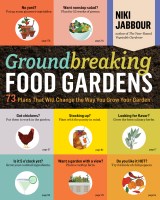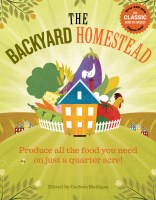How to Grow Your Own Chickpeas (Garbanzo Beans)
If you love edamame beans fresh from the garden, you might like growing your own garbanzo beans. They’re easy-chickpeas-y, and delicious whether you’re drying them or eating them green.

If I could only grow one crop in my vegetable garden, the choice would be easy. It wouldn’t be tomatoes; it wouldn’t be cucumbers or carrots. I would grow edamame beans (known to some as “edible soybeans” — which, of course, causes one to question the edibility of the variety grown as a commodity crop). It’s one of those vegetables that tastes so much better when it’s fresh, it’s almost not worth eating out of season. The fresh beans, when you pop them out of the pod, are silky, sweet, and nutty-flavored. Sprinkled with a bit of salt and eaten with a beer in hand (hence the name of one variety, ‘Beer Friend’), there’s almost nothing tastier.
My love of edamame has led me to other green-podded crops over the years: lima beans, young shell beans, and a handful of others. Niki Jabbour, in her book Niki Jabbour’s Veggie Garden Remix, describes growing chickpeas to eat green, which intrigued me. After editing the book, I added chickpeas to my list of crops to try — someday, anyway.
Visiting relatives in Mexico this winter, I was excited to have my own green chickpea encounter, without even having to grow them myself. Passing the street vendors selling plastic cups of sliced pineapple, ice cream, and churros, I spied a man with a makeshift outdoor cooker and a cart piled with green pods and ears of corn. I thought, “What an odd thing, to find edamame on the street in Mexico!” As I came closer, I realized they were, in fact, green chickpeas. So, of course I had to try some.
The man scooped up a large bagful for me, squeezed lime and sprinkled chile and salt onto it, and handed it over with a smile. They were delicious, of course — what food slathered with lime and chile isn’t? A few of the chickpeas toward the bottom were unadulterated, so I did have a few bites of pure green pea. They were soft, sweet, and buttery — I’m definitely adding them to my list of green-podded crops to grow! Here are Niki’s tips for garbanzo-gardening success.

Growing Chickpeas: The Details
Chickpeas, aka Garbanzo beans, Cicer arietinum
Days to Maturity: 80 days for fresh, 100 days for dried
Hails from: Middle East
Chickpeas You Should Try
Kabuli and Desi Types. Although it’s hard to find named varieties of chickpeas in catalogs, you can choose from the two main groups: large-seeded “kabuli” and smaller-seeded “desi.” Kabuli types make up the majority of chickpeas grown in North America, and desi types are popular in the Middle East and India. ‘Kabuli’ and ‘Desi’ are sometimes listed as cultivars in seed catalogs.
- ‘Black Kabuli’ (80 days fresh, 100 days dried), also seen as ‘Kabouli Black’. This unusual variety is available from Baker Creek as well as Salt Spring Seeds (distribution in Canada only). When mature, it has purple-black seeds. It is well adapted to my cool climate, reliably growing well and ready to pick as a “green crop” in mid-August.
- ‘Chickpea of Spello’ (80–85 days fresh, 100 days dried). An Italian variety, this one is lovely when eaten as a fresh shell bean. The plants grow up to 2 feet and produce a high number of the small, bright green pods.
How to Plant
I plant chickpeas in a sunny bed with well-drained average soil. The “well-drained” part is very important, as chickpeas will quickly die if left with wet feet. Chickpeas also won’t yield well in rich soil, a lesson I learned when I babied my first crop. Now I just amend the soil with an inch or so of compost before planting.
When to Plant
Chickpeas are a long-season vegetable and grow best in regions with long periods of cool to warm temperatures. The planting date for chickpeas can determine the success of your crop, especially for those in regions with short growing seasons. Plant too early and the seeds will rot in the cold spring soil; plant too late and yields may decline because the plants are exposed to temperatures above 85°F (29°C) during flowering. Extended high temperatures can cause buds, flowers, or pods to drop.
So, when to plant? Direct seed around a month before the last expected spring frost. Plant the seed about 1½ inches deep and 3 inches apart, eventually thinning to 6 inches apart. I’ve also had success starting the seeds indoors 4 to 5 weeks before the expected last frost date and moving the young seedlings to the garden once the danger of frost has passed. Germination will take 7 to 10 days, depending on soil temperature and moisture.

Pretty and Not Fussy at All
Chickpea plants will grow up to 2 feet tall and form a dense mat of lacy, gray-green foliage with small, pealike flowers in shades of white, purple, or pink emerging in mid-summer. As such, they make a very pretty edge along a perennial garden. They’re also pretty in containers, but don’t expect them to produce a large harvest when planted that way. I do give the bed an inch of water per week if there has been no rain, but the plants are quite drought tolerant and need little fussing.
If you’ve never grown this crop before, it is helpful to order a packet of the inoculant, as it will certainly boost yield. The bacterium is a different strain than what is commonly used for snap beans, so be sure to order chickpea-specific inoculant.
Good Green Pods
We prefer to harvest our crop when the pods are immature; at this stage, the wrinkly, green seeds inside have a delicious pea-bean flavor. Sometimes we turn excess young seeds into a fresh hummus, but more often than not we all gather at the table with a pile of the pulled plants, grabbing the pods and squeezing out the seeds to eat raw like shell peas. Excess green chickpeas can also be blanched and frozen for a winter dish of green hummus.
For dried beans, allow the pods to dry on the plants, and then shell and gather the dried seeds. If damp weather threatens the crop, pull the almost-dry plants and hang them in an airy place indoors to finish the drying process.
“Growing Chickpeas: The Details” text excerpted and adapted from Niki Jabbour’s Veggie Garden Remix © 2018 by Niki Jabbour.
2019 GardenComm Media Awards Gold Medal Winner
Best-selling author Niki Jabbour invites you to shake up your vegetable garden with an intriguing array of 224 plants from around the world. With her lively “Like this? Then try this!” approach, Jabbour encourages you to start with what you know and expand your repertoire to try related plants, many of which are delicacies in other cultures. Jabbour presents detailed growing information for each plant, along with fun facts and plant history. Be prepared to have your mind expanded and catch Jabbour’s contagious enthusiasm for experimentation and fun in the garden.












